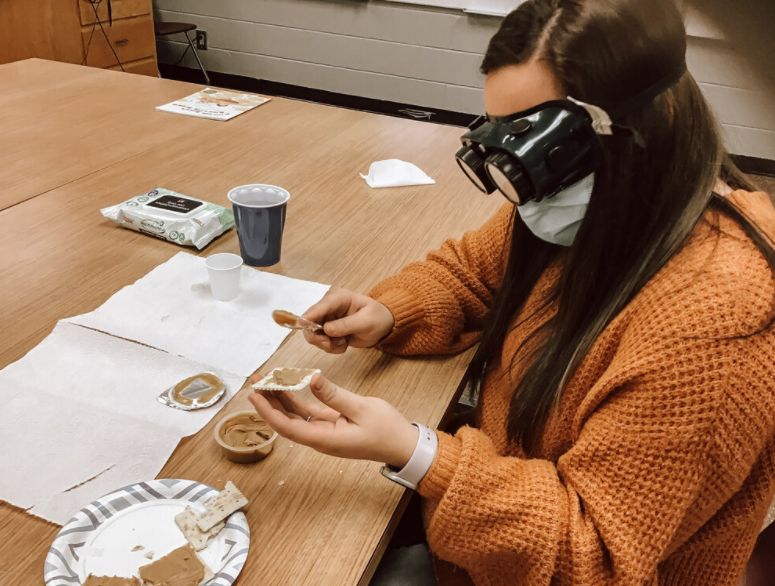Seeing was believing for students in Theresa Ferg’s SPD368 Verification of Children with Disabilities class recently.
With the assistance of vision goggles borrowed from the Nebraska Instructional Resource Center for the Blind and Visually Impaired, Ferg’s students got a better view of what visually impaired students go through everyday of their lives.
It was the first time Ferg had incorporated the goggles into her preparation. The goggles offered a variety of impairments, which could feature anything from blind spots to depth perception. “We were able to simulate different levels of visual impairment,” Ferg, an Associate Professor of Education, said. “Each of them would put on the different goggles and we had them do a variety of everyday tasks, like reading, putting peanut butter on a cracker, pouring water, or playing catch. They could only see out of certain spots, which made it very difficult and frustrating for them. When they were trying to read, they would often have to use their finger so they wouldn’t lose their place. When they were trying to catch the ball, you could see their depth perception was way off.”
Haley Bazis, a senior Elementary Education major with endorsements in SPED and ESL, said the experience was an awakening one for her and her classmates. “My initial reaction was ‘Wow!” she said. “Some of the goggles gave me an extreme headache, changed the color of the room, or even had only a small hole that you could look through. It was very disorienting to try to do things like read a children’s book or even spread peanut butter on a cracker (my knuckles were covered).”

It gave students the opportunity to see the world from a different view, and understand the role they may play one day as they connect with visually impaired students. “ I gained a new understanding of what students with a visual impairment go through every day,” Bazis said. “It really shows how resilient kids are and the amount of work they are willing to put in to succeed!”
Ferg believes it was an invaluable experience for her students as they gained a new perspective on what daily life is like for visually impaired individuals. “As a teacher, you have to make all kinds of accommodations and modification in your classroom for students who are visually impaired ,” Ferg said. “This class focuses on all the thirteen handicapping conditions students may have and vision is the easiest one to simulate. You can talk about it, but until you put on these goggles and can’t see, you don’t truly understand the impact.”
Ferg said that getting that first-hand look is the greatest teaching method of all. “I love it because it’s something different for our students,” she said. “But we only had to do this for a short amount of time. I think at first, our students thought it was fun. But as they started to do things, they realized that for individuals with a visual impairment, this is their everyday life. Anytime we as teachers can put our Midland students in these situations, even uncomfortable ones, we hope it can make them understand and be more sympathetic to the needs of their students.”
Bazis hopes the experience will further her development as a future educator and help her gain a better understanding of how to work with visually impaired students. “I believe that empathy is such a large part of being an educator. We got the opportunity to literally see through the eyes of our students and understand some of the struggles they are experiencing when doing tasks that we see as basic,” she said. “It is extremely fatiguing to read a passage when you have to keep one eye shut to see clearly or to have to move your head until the words are in the small circle of sight.
Experiences like this give us the opportunity to understand how harmful and frustrating some of our teaching practices can be like ‘are you looking at the word or just guessing’ and gives us the opportunity to see why children may need a break while they are reading.”